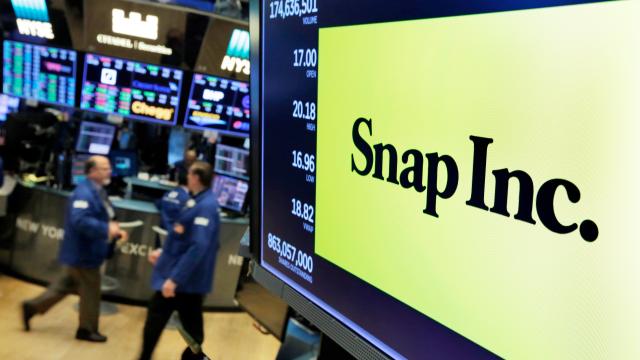Snapchat owner Snap Inc. has had a rough go of it lately. Its stock, which hit the market at $24 per share (and peaked at $41) during its initial public offering in March 2017, is in the gutter—a high of $9 so far in 2019.
It’s seemingly hit a wall in growth, and it’s still bleeding cash. A major update to the app last year was hated on by so many users Snap was forced to issue a redesign of the redesign.
According to Reuters, sources at the company say Snap it is now considering “what was once unthinkable”—namely, switching up its format so that public Snaps last much longer before being deleted (not that big a change) or simply become permanent (a much bigger change). It is also considering a switchup that would “reveal the identities” of users who make public posts.
While the changes would push more content on Snapchat to more eyeballs, the company is not about to abandon self-deleting posts entirely. Reuters wrote that the changes Snap is mulling would only apply to posts submitted to Snapchat’s “Our Story” feed (a public section where users can send their posts), and users would still be able to manually delete them:
Only Snapchat photo and video content shared to “Our Story”, which shares the snaps publicly to a wider audience and not just a user’s friends, would be affected and users would still have the option of deleting those stories, said the person.
Snap has already extended the shelf life of public stories, but making them last even longer or revealing more about the users who create them would be a further departure from Snapchat’s hallmark features.
Snap declined to comment.
One source additionally told Reuters that Snap is currently considering how those changes would work from privacy, technical, and legal angles. The news agency also wrote that the proposed changes seem to be motivated in part by Snap’s partnerships with “news discovery platforms” (i.e., services that spot trending news for media companies).
They are intended to make it easier for third parties to recirculate Snapchat content outside the app, with Reuters writing that sources said “some partners have said that the disappearing and anonymous nature of public stories makes them difficult to work with.”
In other words, Snap would really like it if more people embedded its content in blogs, news articles, other social networks, and the like, which would provide new advertising opportunities.
It would also, in theory, position Snap to better compete against Twitter and Facebook, both of which are often the launching point for major news stories (in just one recent example, the headache-inducing Covington Catholic video). As Reuters noted, public stories on Snapchat already last 90 days, up from the 30 when the feature was originally introduced.
Of course, these changes would take Snapchat even further away from its original conception and risk alienating some of its users, who are infamously touchy. On the other hand, holy cow this company is burning through a lot of money.
In Q3 2018 it reported a negative free cash flow of $220 million, a number that in large part looks good because of its Q2 2018 negative free cash flow of $325 million. TechCrunch reported that Snap only had $2 billion in assets remaining at the end of that quarter, and with “analyst MoffetNathanson estimating it will lose $2 billion in 2019 alone, Snapchat could run out of money well before it’s projected to break even in 2020 or 2021.”
That leaves it in serious need of new sources of revenue.
“We do not see Snap reaching profitability in the near future unless there are substantial expense reductions,” MoffetNathanson’s Michael Nathanson wrote, per Bloomberg. “In 2019, Snap will have to make some moves to ensure it has the liquidity to stay in business.”
Snapchat has also been losing users. It posted a three million daily user loss in Q2 2018, then lost two million more in Q3 2018. Snap has also been brutalized by Facebook subsidiary Instagram, which is flush with cash and claims to have well over 400 million daily active users.
A poll in October 2018 found that Instagram may be overtaking Snapchat in monthly use among teens, as well as found many more of them “prefer brands contacting them about new products” on the former than the latter, CNBC wrote.
[Reuters]
